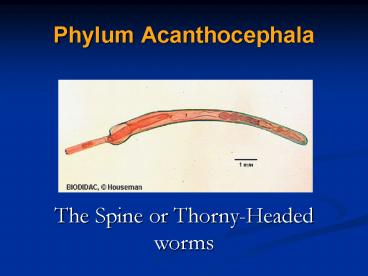Phylum Acanthocephala - PowerPoint PPT Presentation
1 / 13
Title:
Phylum Acanthocephala
Description:
The molting aschelminthes are related to arthropods. ... freshwater), birds (chickens and turkeys are of economic importance), mammals, ... – PowerPoint PPT presentation
Number of Views:2856
Avg rating:1.0/5.0
Title: Phylum Acanthocephala
1
Phylum Acanthocephala
The Spine or Thorny-Headed worms
2
Phylogeny
3
Acanthocephala
- Characteristics of the Aschelminthes
- Two main groups Molting and non-molting.
- Acanthocephalans and Rotifers are non-molting.
- The molting aschelminthes are related to
arthropods. - Pseudocoel formation from persistent blastocoel.
- Does not form by schizocoely or enterocoely (i.e.
not from true mesoderm). - Eutely
- Cell division stops at the end of embryonic
development. - Growth by increased size, not increased cell
number. - Tissues and organs composed of a species
specific, fixed number of cells.
4
Characteristics specific to Acanthocephala
- Spiny or thorny-headed.
- Less than 1,200 species described.
- All are intestinal parasites of vertebrates.
- Common in various fishes (mostly freshwater),
birds (chickens and turkeys are of economic
importance), mammals, and a few reptiles and
amphibians. - Arthropods sometimes required as intermediate
hosts. - Typically cylindrical and small (just a few
millimeteres up to a few centimeters). - Constant number of cells, which is species
specific. - No specialized respiratory structure.
- Comparatively large pseudocoel.
5
The Acanthocephalan Body
- Proboscis.
- Hollow and fluid filled.
- Numerous biochemically hardened hooks or spines.
- Important for species identification.
- Most species have receptacle for retraction.
- Separated from body by septum.
- Brain located at the base of the retractile
sheath. - Sensory organs are usually only of a tactile
nature. - Not much of a view.
http//www.umanitoba.ca/faculties/science/zoology/
faculty/dick/z346/echinorhome.html
6
The Acanthocephalan Body
Close up of the proboscis
Youve got a problem if
How the proboscis attaches to the intestinal wall.
All images from http//www.biosci.ohio-state.edu/
parasite/acanthocephala.html
7
The Rest of the Body
- Claim to fame The only protosomes with no
mouth, anus or gut. - Food is absorbed from the surrounding intestinal
juices. - No circulatory system.
- Excretion system.
- Protonephridia which empty into the bladder.
- Bladder empties into sperm duct in males and into
the lower part of the uterus in females. - Skin.
- Covered with muccopolysaccharides and a
non-cellular cuticle. - Epidermis has pores that lead to a network of
channels distributing nutrition. - Musculature
- Thin outer radial muscles.
- Thicker, inner longitudinal muscles.
8
Male Reproductive System
- One ligament sac.
- Two testes located in ligament sac.
- Cement glands.
- Protein that hardens after sperm deposit.
- Penis projects into the bursa.
- Bursa is eversible to grab female.
- Two genital ganglia (nerves) connected by a nerve
ring.
http//www.umanitoba.ca/faculties/science/zoology/
faculty/dick/z346/echinorhome.html
9
Female Reproductive System
- Two ligament sacs, one dorsal and one ventral.
- No defined ovary.
- Fragments called ovarian balls float freely in
ligament sacs. - Only mature eggs are able to pass through the
uterine bell, immature eggs are returned to the
ligament sac.
http//www.umanitoba.ca/faculties/science/zoology/
faculty/dick/z346/echinorhome.html
10
Reproduction The Logistics
- Internal Fertilization.
- The males bursa is wrapped around the females
posterior end and sperm is deposited. - Sperm migrates up the vagina to fertilize the
eggs. - Proteins from the cement glands harden in the
vagina, preventing sperm escapees. - Eggs develop into the acanthor stage, or the
advanced and differentiated state. - Ligament sac ruptures and larvae released into
psuedocoel. - Larvae passed out through uterine bell
contractions into the surrounding fluid. - The hardy larvae can remain viable for several
months. - Females can produce more than 1 million eggs in
her lifetime.
http//www.umanitoba.ca/faculties/science/zoology/
faculty/dick/z346/echinorhome.html
11
Development
- Lavae are expelled in the host feces in the
acanthor stage. - They have a hard protective shell which provides
protection and desiccation prevention. - Most species require development in an
intermediate host. - Usually insects for terrestrial life cycles.
- Crustaceans for aquatic.
- When ingested by intermediate, the acanthor
usually hatches from shell and bores into
hemocoel (the blood sinus or cavity) for
development into the cystacanth. - Adulthood is reached when the intermediate host
is consumed by the correct vertebrate host thus
transferring the cystacanth.. - Many species can tolerate ingestion by more than
one intermediate host.
12
Acanthocephalan Classes
- Class Archiacanthocephala.
- Only class with specialized excretory system.
- A cool species Macracanthorhynchus
hirudinaceus. - Females can reach up to 70 cm.
- Dont worry, they mainly parasitize swine with
beetles as intermediate hosts. - Class Eoacanthocephala
- Mostly parasitize fish with crustaceans as
intermediates. - Class Palaeacanthocephala.
- Most specious class.
- Parasitize all vertebrates.
- Alter host behavior???
13
Altered Intermediate Host Behavior
- Research has been done on various arthropods
infected with acanthocephalan parasites. - Mostly involving cockroaches, crustaceans, fleas
(amphipods), pillbugs (isopods), and ostracods. - Behaviors that were significantly changed.
- Amount of activity
- Altered photic response.
- Amount of exposure.
- Substrate color choice.
- Consequences of those behaviors.
- Increased visibility as prey.
- Benefit to parasite.
- Infected arthropods may exhibit atypical
behaviors in response to parasitic
(acanthocephalan) infestations, which promote
predation and the subsequent transfer of the
parasite to the appropriate, definitive host.































